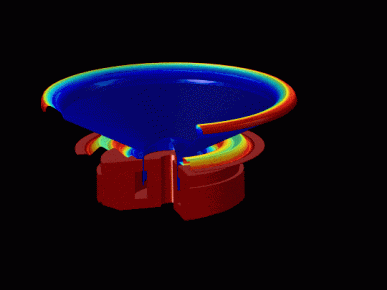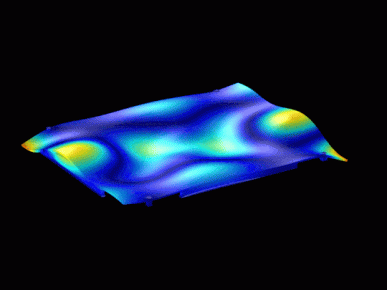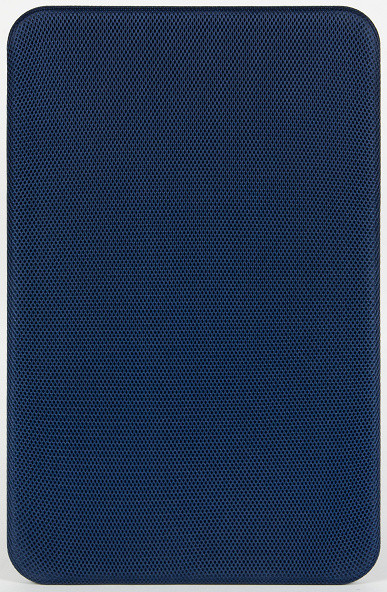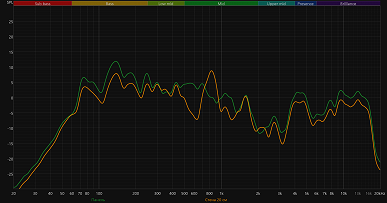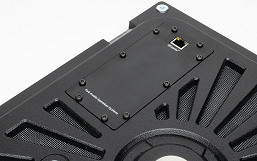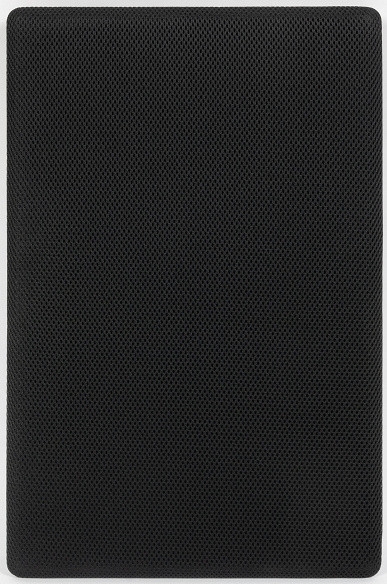The speaker market is constantly evolving, although new technologies can hardly be called fundamentally new. However, when a manufacturer announces a technology that is very different from the usual, it arouses interest. Tefra Audio has developed Nevis speakers using a unique technology that differs from traditional electrostatic drivers. They compare the process of sound generation to an earthquake, and the device itself to musical strings. The membrane is brought into resonance by a magnetic coil, which creates sound waves.
Nevis were completely developed by Russian specialists, which adds interest to the product. The company independently produces membranes and some coils. Assembly is carried out on the territory of Russia. Although Nevis are intended for professional use, they can also be used in home audio systems.
Specifications
| Claimed RMS Power | 70 W |
|---|---|
| Peak power | 140 W |
| Claimed frequency range (±6 dB) | 50 Hz — 18 kHz |
| Sensitivity | 94 dB |
| Directional pattern | 360° |
| Maximum sound pressure SPL | 100 dB |
| Nominal resistance | 4 ohm |
| Dimensions | 370×610×38 mm |
| Weight | 3.4 kg |
History of technology
The idea of Distributed Mode Loudspeakers (DML) arose almost simultaneously with traditional speaker design, but remained in the shadow of technical developments in loudspeaker systems. Unlike traditional speakers, DML loudspeakers have no physical limitations, allowing you to create speaker systems with a new level of sound quality.
The first attempts to use DML technology to reproduce sound were made in 1922. However, it was not until 1991 that the technology was used to reduce noise in aviation, after which it was patented and began to attract attention. This led to the creation of a holding company, NXT New Transducers Ltd., which conducted significant research into DML technology and filed numerous patents.
Henry Azima, one of the founders of NXT, became a monopoly owner of patent rights to DML technology, which became both an advantage and a hindrance to the development of the area. However, over time, many patents have become invalid.
There are several companies that have tried to implement DML technology in speaker systems, but most of them were unable to achieve high sound quality. DPK TST is one of the few companies that have developed their own technology, which made it possible to fully implement the operating principle of DML loudspeakers.
Design
DPK TST loudspeakers use bending transverse waves generated on the surface of the radiating membrane to create sound. These waves are generated by electromechanical actuators attached to the membrane. In this case, bending waves are reflected from the edges of the membrane, forming complex modal structures on its surface, which, in turn, generate sound waves in the environment. This process is the opposite of the cone action of traditional speakers, where they try to minimize flexural waves and ensure that the speaker operates exclusively in piston mode.
This type of exciter is essentially an electrodynamic transducer, similar to a conventional speaker, except that instead of a cone, a flat membrane is used, to which a voice coil is attached. The main difference from a traditional speaker is that such a drive forces the membrane to operate in maximum bending mode, while classic speakers operate in piston mode.

Exciter circuit
The phenomenal properties of the sound created by DPK TST technology are surprising to specialists whose knowledge is based on traditional paradigms. However, their stupor is explained by the fact that these properties do not fit into the usual textbooks and ideas. Let's look at four key characteristics that differentiate the sound from DPK TST panels from the sound generated by traditional speakers:
- Circular radiation pattern above the phase transition frequency. This means that the membrane operates in distributed mode mode, providing a uniform sound picture throughout the entire space.
- The ability of sound waves to bend around obstacles, exhibiting diffraction up to the highest frequencies. Unlike traditional speakers, this allows you to get high-quality sound anywhere in the space.
- Unusual sound pressure drop, close to a linear function. This means that even in far-field listening areas, the sound remains crisp and clear without the need to use excess power.
- Higher frequency response uniformity at different listening points, which ensures a uniform sound field and the absence of standing waves.
These features make the sound from DPK TST panels unique and unattainable from traditional speakers. DPK TST technology works on the principle of decomposing the audio signal into its component frequencies, creating a kind of sound rainbow with minimal loss in sound transmission and providing clear, accurate and natural sound at any listening point.
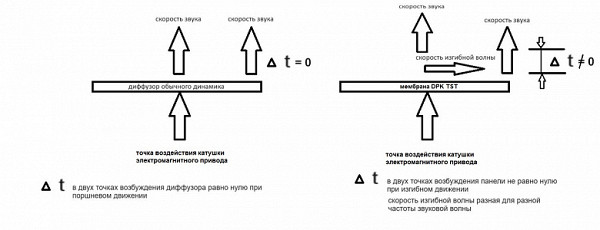
In addition, the waves excited in this way have a number of unique physical properties that bring significant benefits to our acoustic systems:
- In a traditional speaker, the size of the cone limits the upper limit of the frequency response. With the DPK TST panel there are no such restrictions, making the technology truly scalable. Larger panels retain directivity and high frequencies, and increasing their size improves performance by lowering the fundamental bending resonance frequency and expanding bass response.
- An important advantage is that the acoustic power of the DPK TST panel is used on both sides. The power emitted from the back side is combined with the power from the front side, increasing overall efficiency and sound quality.
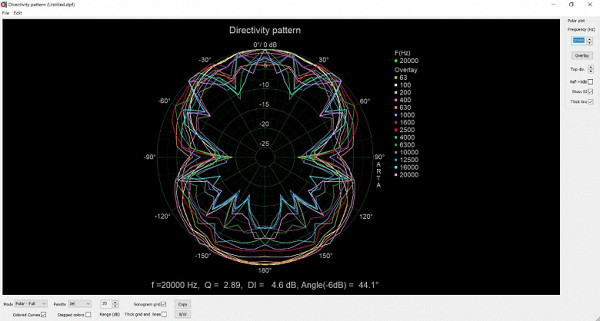
3. DPK TST systems have incredible performance and generally outperform other types of speakers. This is because the panel oscillates very little in the frequency range of interest, reducing the need for coil deflection while still allowing the panel to remain within its linear elastic range.
4. The sound from DPK TST systems has a circular radiation pattern, and their diffusion properties reduce destructive interactions. Studies have shown that stereo panorama at home remains stable and readable, in contrast to conventional loudspeakers, which only provide good listening in a narrow “sweet spot” zone.
5. DPK TST systems are compatible with conventional amplifiers and do not require additional technical means.
6. DPK TST acoustic systems, being unframed, are devoid of coloration and distortion characteristic of systems with acoustic filters and large cabinets.
7. DPK TST systems fill space with a sound field that barely changes as the listener moves. This is achieved by reducing the drop in sound pressure level with distance and due to the unique diffraction ability of MF/HF waves.
Sound transmission through shear waves generated on the surface of the membrane is a key mechanism for the operation of DPK TST systems. In practice, this occurs through the formation of complex clusters of standing waves, which in turn create sound waves in the air. Such sound waves have both longitudinal and transverse components.

The human ear is capable of perceiving perfectly balanced sound, which includes both longitudinal and transverse components of the sound wave. This makes the sound natural and natural to us. However, speakers only work with the longitudinal component of sound, so even with the best efforts of engineers, the reproduced sound will not always be able to compete with natural perception.
We expressed interest in the internal structure of the speakers we tested and requested permission to disassemble them. The developers confirmed that the speakers can be disassembled, but warned that putting them back together may be difficult. The internal structure of the acoustics remains a secret that the manufacturer does not want to fully disclose. However, we were provided with a render showing the main elements of the speakers.
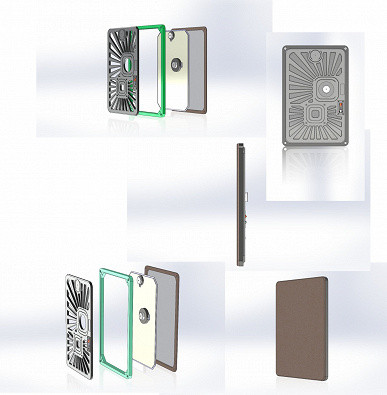
In addition, we were provided with a photo of the speaker with the back wall removed. Although the coil markings have been obscured, from the two images provided you can get a basic idea of the inside of the speaker.
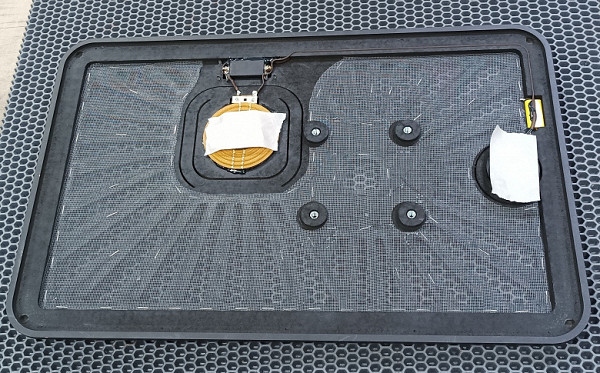
Appearance and Design
The design of the Tefra Audio Nevis speakers is very minimalist and functional — no unnecessary decorations, just fabric-covered panels with rounded corners. The main attention is attracted by their compact dimensions and light weight — only 370x610x38 mm and 3.4 kg. They can be easily moved, even when held with one hand. In addition, selecting brackets for them is not difficult, because with a weight of only 3.4 kg they can be installed on almost any suitable surface.

The front panel of the speakers is covered with sound-transparent fabric. We received blue speakers, but you can order any color or even print an image — there are many options for personalization. On the rear panel you can see places for coils, as well as a VESA mount on the top and in the lower right corner, which helps to place the speaker optimally. Next to the bottom coil there are terminals for connection.
The most amazing thing is that the panels are only 38 mm thick. When installed next to a wall, they are almost invisible, especially if covered with fabric in the same color.

The back panel is made of thick plastic, but thanks to the textured painting it looks very solid.
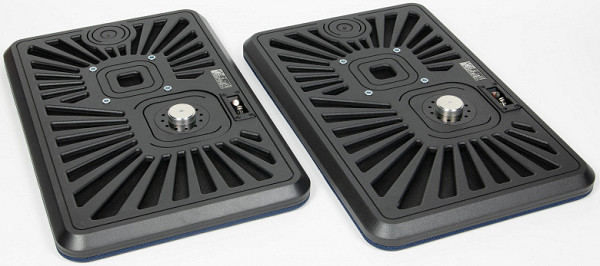
The only protruding element on the rear model is the bottom coil magnet. The installed mount will also inevitably increase the thickness of the column.

Connection and operation
Connecting Tefra Audio Nevis speaker systems is carried out in a standard way: one end of the cable is connected to the amplifier, and the other to the speaker. The terminals are clamping and securely fix the wires. The internal diameter of the terminals allows the use of wires with a diameter of up to 2.5 mm.

To install the speakers, a standard VESA mount measuring 100x100 mm is used. You can use almost any TV or monitor bracket — be it wall-mounted or desktop.
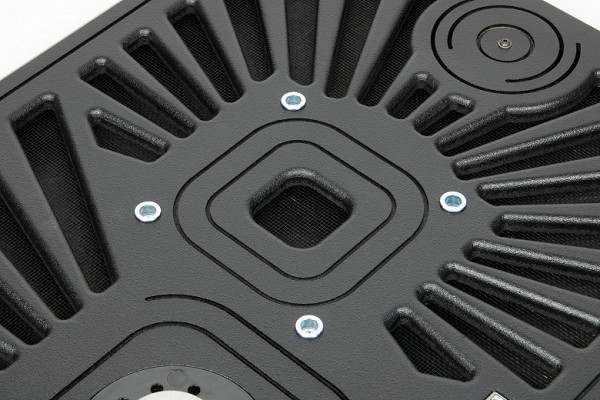
We used a desktop monitor mount as recommended by the speaker manufacturer. This allowed us to place the speakers comfortably and securely on the table, and also easily adjust their position as desired.
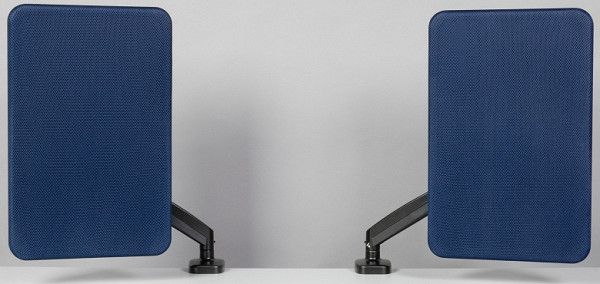
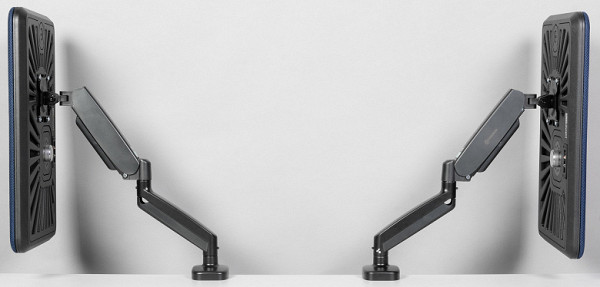
Sound and frequency response measurements
To begin with, we placed the speaker in a specially prepared room and installed an acoustic panel behind its back wall to minimize sound reflections. The microphone was placed normal to the plane of the speaker at a distance of about 1 meter, orienting it approximately to the center of the front panel.
We remind our readers that the graphs presented below are for illustrative purposes only and should not be used to make a final judgment about the quality of the acoustics being tested. Measurement results may vary significantly depending on microphone position, audio path components used, listening room conditions, and other factors.
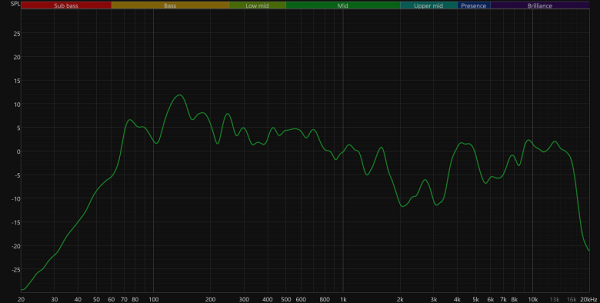
When it comes to sound, the Tefra Audio Nevis speakers have some interesting features. Firstly, they sound surprisingly good for their compact size. Despite this, they are capable of reproducing frequencies up to 60Hz, which may be a bit of a surprise given their size. However, if you want deeper bass, you may need to add a subwoofer to the system. Overall the sound is not overly «monitor-like», with a distinctive character that you may or may not like depending on your preferences.
The midrange doesn't sound quite smooth due to some dip in the upper mids, which can negatively affect the detail of vocals and instruments. However, a slight boost in another area gives the sound purity and clarity. There are practically no problems with sibilants here, which is a plus. As for the treble, it is cut off at around 18 kHz, which may upset some audiophiles' expectations. However, for most listeners this will not be a problem, given that most of us are no longer able to hear frequencies above 18 kHz.
The bass has excellent attack and is delivered clearly, without any of the buzz that is common in some other speakers. There is a slight peak around 70Hz, which is likely caused by minor chassis vibration, but it doesn't detract too much from the overall low-frequency experience.
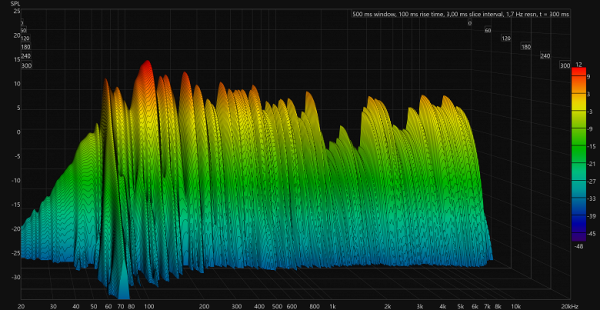
Now let's remove the acoustic panel from the back and listen to how the speaker sounds with reflections from the wall. We see changes in the sound, which gives us an understanding that there is room for experimentation when placing speakers. However, the overall picture does not change too significantly.
Let's compare the sound in front and behind the speaker, since so much has been said about it above. Obviously, there are differences and they should be taken into account. But the column sounds backwards, that's a fact.

Now let's take two speakers and try to place them indoors where we listen to music. We will place them as close to the center of the room as possible, moving them away from the walls. We will move the microphone for measurements to the center between the speakers at a distance of about 2 meters from each. And the good news: the “dip” in the upper mids of the sound has decreased significantly. It is still there, but its influence on the subjective perception of sound has become much less.
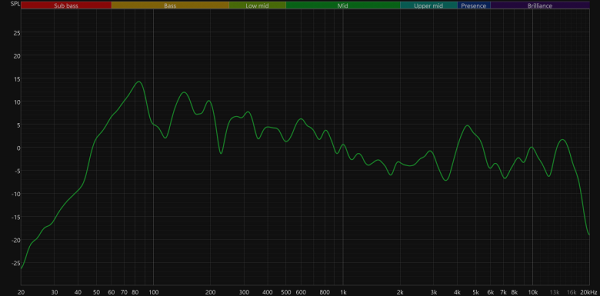
Let's look at the «waterfall» again. We notice that there are small peaks in the low frequency range. This is due to the fact that the sound began to “come to life” in the room — even in well-prepared rooms this is a completely natural phenomenon. But overall, the situation looks pretty decent, and we can consider that we have found the optimal place for listening.
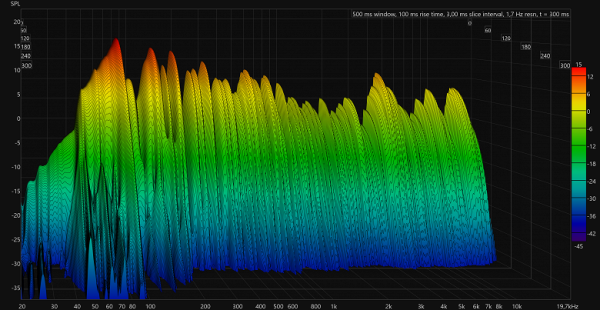
In the final step, we will pay attention to the horizontal dispersion of the sound by turning the speakers towards each other, while maintaining the position of the microphone. We see that the changes in sound are very small, which means that there is no need to very precisely adjust the direction of the speakers to the listener. However, it is worth keeping an eye on this aspect, if only to ensure the optimal distance between them and achieve the best stereo effect.
The developers of Tefra Audio Nevis correctly claim that their speakers create a noticeable stereo effect, and the space in which it is perceived is much wider than that of traditional acoustics. However, if the speakers are placed too close, this effect may be blurred — in this regard, more directional classical acoustics may be less demanding.
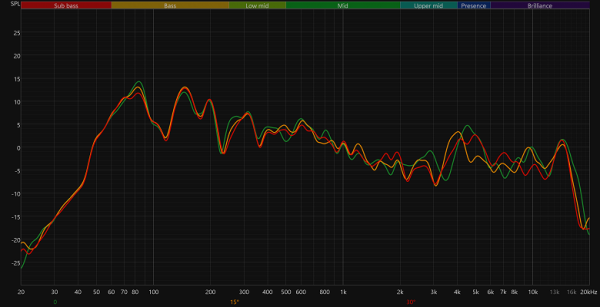
In the final step, we will pay attention to the horizontal dispersion of the sound by turning the speakers towards each other, while maintaining the position of the microphone. We see that the changes in sound are very small, which means that there is no need to very precisely adjust the direction of the speakers to the listener. However, it is worth keeping an eye on this aspect, if only to ensure the optimal distance between them and achieve the best stereo effect.
The developers of Tefra Audio Nevis correctly claim that their speakers create a noticeable stereo effect, and the space in which it is perceived is much wider than that of traditional acoustics. However, if the speakers are placed too close, this effect may be blurred — in this regard, more directional classical acoustics may be less demanding.

We continue our acquaintance with various genres of music on Tefra Audio Nevis acoustics. This time our playlist included pop music from Rihanna — the track “You Da One”. This composition sounds unusual and lively on Tefra Audio Nevis speakers, adding its own color to them. The high-frequency range may seem a little lacking, especially when listening to high-pitched hi-hats, which sometimes get lost in the background of other sounds. However, overall the track sounds interesting and lively, allowing you to hear it from a new angle and enjoy a non-standard interpretation.
Let's move on to the classic rock music — the track “Rock And Roll Music” by The Beatles. This good old rock sounds very organic on Tefra Audio Nevis, as if the speaker system transforms time, taking us back to the past. It is perceived not as modern advanced speakers, but as something vintage from the last century. This creates a unique atmosphere that is difficult to convey in words.
The next track, Bennet — “Vois sur ton chemin (Techno Mix)”, is a prime example of electronic dance music. On the Tefra Audio Nevis speakers, the sound of this track feels omnipresent and powerful. The kick hits you straight to the chest, creating a real techno party vibe. It is important to note that even with aggressive bass, the midrange is not lost, maintaining sound balance.
These examples demonstrate how diverse and lively music sounds on Tefra Audio Nevis acoustics, adding to each composition its own special charm and atmosphere.
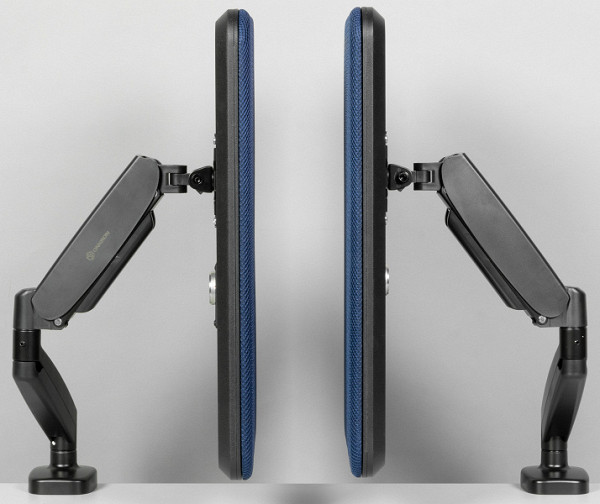
Let's move on to calmer music, starting with the greatest jazz record of all time, Miles Davis' Kind Of Blue. The Tefra Audio Nevis sound on this recording proves ideal for small jazz ensembles. Although there are some shortcomings, such as a lack of midrange emphasis and slight depth issues, the sound is still enjoyable and allows you to fully immerse yourself in the music.
From jazz we move on to classical music — to Sergei Prokofiev’s ballet “Romeo and Juliet”. Listening to the first movement of the orchestral suite “Montagues and Capulets” on Tefra Audio Nevis leaves a pleasant impression. Although the acoustics may not be suitable for analytical listening due to the inability to isolate individual instruments, the overall orchestra sounds impressive and monolithic as a single instrument.
Finally, in the final stage we enjoy some pleasant lounge music presented by Fakear's track “Elysium”. The sound at minimum volume perfectly fills the space, maintaining a balance between bass, vocals and drums. This music is great for relaxing and creating a cozy atmosphere at home.

Today we are especially interested in the issue of minimum volume. There's really no point in turning the knob all the way up to hear the sound — the Tefra Audio Nevis works great at medium volumes and even lower. However, if you reduce the volume even more, the “punch” in the bass is lost, and the middle becomes less readable. At low volumes the acoustics perform well, but not as impressive as some other models.
In general, the sound of these speakers is very specific: it is far from ideal and monitor-like, but at the same time holistic and lively. Many may not like it right away, but for those who prefer live bands and often listen to old records, they can be a real discovery. Tefra Audio Nevis sound nice, a little vintage and very impressive.
Tefra Audio Agilera
To carry out the main part of the testing, we chose the Tefra Audio Nevis model, which is the easiest to imagine in a home audio setup for a lover of high-quality sound with an appropriate budget. However, we also had the opportunity to review a more affordable model that uses the same technology but is aimed at the public address market such as conference rooms and notification systems.
Although this model is not the cheapest, the manufacturer claims that due to the uniform distribution of sound, high speech readability and the minimum number of necessary components for sounding a room, the consumer can even save money in the end. First of all, we will look at the technical characteristics and note that the declared frequency range of this model is much narrower than that of the previously reviewed acoustics. This is quite normal for speakers focused primarily on speech reproduction.
| Rated power | 20 W |
|---|---|
| Peak power | 40 W |
| Claimed frequency range (±6 dB) | 60 Hz — 15 kHz |
| Sensitivity | 87 dB |
| Maximum sound pressure SPL | 100 dB |
| Horizontal/vertical coverage | 180° |
| Nominal resistance | 8 ohm |
| Dimensions | 451×291×38 mm |
| Weight | 900 g |
Otherwise, these are the same acoustics, only smaller and lighter. There are practically no external differences — the same panels covered with fabric.
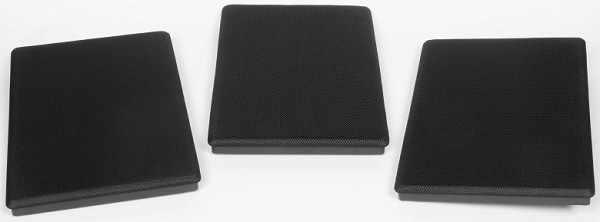
Since Tefra Audio Agilera will be used mainly in a professional environment, there are as many as three versions with different connection types:
- passive
- broadcast with built-in transformer
- with Dante module

This time there is only one coil, next to it there are connectors — terminals for an acoustic cable, RJ45 for a network cable, or terminals for connecting broadcast system cables.
For mounting, you can use VESA brackets, but not only them. There are also holes for eye bolts in the corners, closed with plugs, and special recesses along the edges of the body are designed for mounting into the ceiling using spring clips.
Well, the key feature, of course, is in place: the panels are very thin, the thickness is still the same 38 mm.

Let's measure the frequency response in the same way as described at the very beginning of the previous chapter. It can be seen that the main sound features are fully preserved.
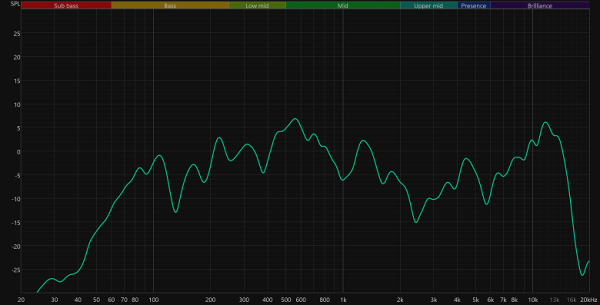
The edges of the range were noticeably cut off and the midrange was emphasized, which is typical for acoustics designed primarily for voice reproduction. Above, we examined in detail the acoustic parameters that are important for home use, but there are also features that are valued in a professional environment. We will tell you about them here.
The developers of the acoustics claim that it is not afraid of mechanical damage: even if the membrane is pierced, it will continue to work, which is not typical for conventional speakers. In addition, there is less acoustic feedback from microphones near Tefra Audio speakers. We carried out a test: we brought the microphone to studio monitors and Tefra speakers operating at equal volume. The result was obvious — feedback either did not occur at all, or occurred at a much shorter distance from the microphone to the emitter. In the case of conference room sound, this can greatly facilitate system setup and elimination of feedback without the use of additional equipment or equalizers.
Results
At the moment, Tefra Audio Nevis speakers attract attention more as a technological innovation and an example of the application of original technology than as a product for wide distribution in home audio systems. With a price of $4,500 per speaker, its mass use is hardly justified, and the manufacturer understands this, focusing mainly on the professional segment. However, there are also more affordable models with similar characteristics, but at a more attractive price ranging from $2,250 to $2,800 apiece.
Of course, with a budget of $5,000 for a pair of speakers, the buyer is faced with a huge selection on the market, including products from well-known manufacturers with a long history. However, there is a possibility that Tefra Audio Nevis will interest audiophiles enough that price will not be an obstacle for them. This device will not only fit perfectly into the interior of the room and attract admiring glances, but also represents an opportunity to be at the forefront of technological development, which can attract the attention of tech enthusiasts.
In general, the sound of Tefra Audio Nevis acoustics is extremely specific, but noticeably interesting, with a characteristic “liveness” that causes surprise and admiration. Although it is not suitable for everyone, this speaker is definitely worth a look and is of interest to the general public.

